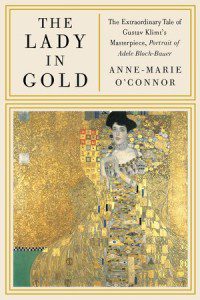
Veteran journalist Anne-Marie O’Connor’s book about the legacy of Gustav Klimt’s masterpiece, Portrait of Adele Bloch-Bauer, previously known as the Lady in Gold, combines detailed reportage with passionate storytelling. This painted portrait, often called the “Austrian Mona Lisa,” was the star of one of the greatest art scandals in modern history. O’Connor follows the painting from its inspiration and inception, through the horrors of World War II and genocide, into modern legal battles over its ownership, and finally into the contemporary American art world.
The story opens at the Belvedere Palace, a fortress of historical art. On a snowy winter morning in 2006, a young lawyer from Los Angeles comes to see Gutstav Klimt’s shimmering gold masterpiece, a portrait of Viennese society beauty Adele Bloch-Bauer. It is one of the world’s most influential modern art masterpieces. A tender image, the painting features a raven-haired beauty with round lips, parted as if about to speak, and a pair of seductive, captivating eyes. Klimt’s style was influenced by Egyptian artifacts and by Ravenna’s Byzantine relics, seen in 1903. He described them as “mosaics of unbelievable splendor.” The gold patterns in Adele’s portrait are reminiscent of those ancient sacred images. The painting is touched with swirls of regal blue, silver and ivory, hieroglyphic eyes, and geometric shapes that collide to create Adele’s dress. Her world is cast in delicate gold leaf.
“Here,” O’Connor writes, “in her naked eyes, lies a story that is more diary than a novel. A painting comes from a time and place.” Adele Bloch-Bauer, a prominent Jewish socialist and hostess of a renowned Viennese Salon at the beginning of the 20th century, might have been Klimt’s most inspirational lover, his muse. There were many allegations made in the European press before their deaths. Contemporary art historians speculate that she was the inspiration behind masterpieces such as The Kiss and Judith and the Head of Holofernes. Although there is no proof of their sexual relationship, O’Connor’s exploration of their personal lives reveals evidence of an intimate relationship. A single photograph of Klimt was on Bloch-Bauer’s nightstand when she passed away, one of the few objects she held close. Klimt drew more sketches of her than he would of any other single patron or subject. She died childless in 1925.

Before World War II, the portrait became a national icon, symbolizing the cultured and sophisticated “modern woman.” But then anti-Semitism erupted across Europe. By the time Adele’s husband died in 1945, Nazis had deported most of Austria’s Jews to concentration camps, including some of Klimt’s former models, friends and fellow artists. Genocide raged across borders. As art became a central component of Nazi propaganda and ideology, the regime systematically looted and stole art collections from Jews then erased any connections to the artworks’ true history. Art became a central medium for racial theorizing, eugenics and the Nazi’s mission to redefine ethnic identity. To strip Klimt’s portraits of association with their Jewish subjects, the paintings were given new names. The portrait of Adele Bloch-Bauer became merely the Lady in Gold.
O’Connor’s writes gruesome depictions of death and hatred, repeatedly referring to these crimes against humanity as ‘”orgies of violence.” Through her stories of Nazi violence against women, the way that the war invaded intimate relationships and families, and the teeming sexuality within many secret Nazi rituals, this book also examines the gendered nature of violence.
In the 1970s, an aristocrat turned investigative journalist, Hubertus Czernin, shocked the world with stories that revealed Austria had a more willing role in the Holocaust than the popular narrative acknowledged. The largest cache of stolen art in Europe had been found in caves outside Alt Aussee, where Czernin summered.
“More than 65,000 Austrian Jews had been murdered. Exiles faced a thicket of unwelcoming laws,” O’Connor writes. “Some 130,000 Austrian Jews had fled, and many of the survivors had emigrated.” Even after the war, only a few thousand European Jews were able to return to Austria and claim any sort of retribution. The Nazi-looted art was distributed to government galleries and institutions, not the families they were stolen from. Infamous artworks with forgotten histories became the norm, until an elderly lady in Los Angeles named Maria Altman, niece of the deceased Adele Bloch-Bauer, decided to sue Austria to get her aunt’s portrait back.
“Once again, the Lady in Gold was reborn,” O’Connor writes. “The portrait had been created, stolen, renamed, consigned to a shadowy underworld. It had miraculously eluded the inferno of war… Adele was now legend.”
The interwoven stories of legal battles reveal how art influences international law, politics, and both collective and intimate memories. They raise concerns about the elitism that surrounds contemporary art and the voyeurism of media coverage. And they wrestle with the question: What is justice?
“What is the meaning of cultural property when patrimony is an arm of genocide,” O’Conner writes. “What is the value of a painting that has come to evoke the theft of six million lives?”
O’Connor grapples with the meaning of the painting: “whether Adele represented the glittering aspirations of turn-of-the-century Vienna, or the sacking of everything that made Vienna shine.
During its creation, Adele’s portrait depicted a triumph of Jewish assimilation and art patronage in Middle Europe, a community that inspired Mark Twain, Sigmund Freud, and countless other creative geniuses. But the crimes surrounding the artwork make it a relic of assimilation’s tragic failure. Unraveling the portrait’s journey also reveals how global norms of art and war have changed, and the powerful roles that art plays in politics, society, identity and memory.
“In the days of Napoleon, war meant booty,” O’Connor writes. “It was accepted: to the victor went the spoils. Now people were disturbed by art taken by force and kept by deception. Restitution cases were now judged in the court of public opinion. The world of today was shocked to discover that even one of the women painted by Klimt was sent at gunpoint to a place where families burned in ovens.”
Frozen in a portrait of Vienna’s golden past, Adele Bloch-Bauer achieved immortality, far more than even Klimt himself could have ever imagined. “And that,” O’Connor decrees, “is the power of art.”




